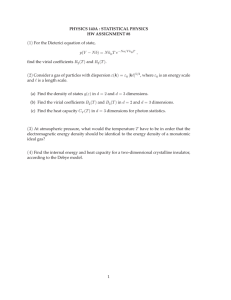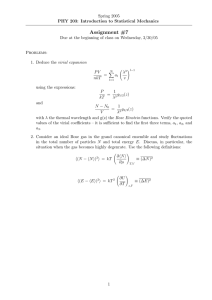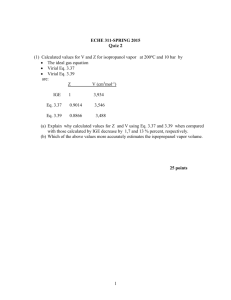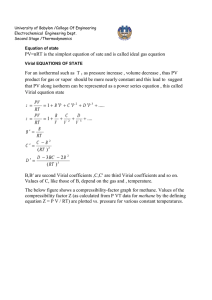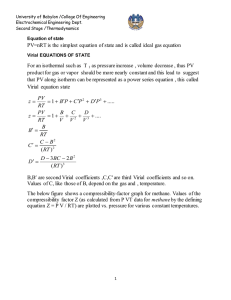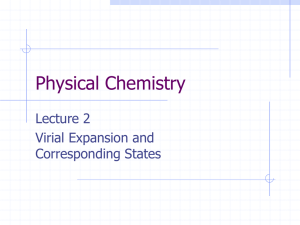Acta Mechanica Solida Sinica, Vol. 22, No. 6, December, 2009 Pu b
advertisement
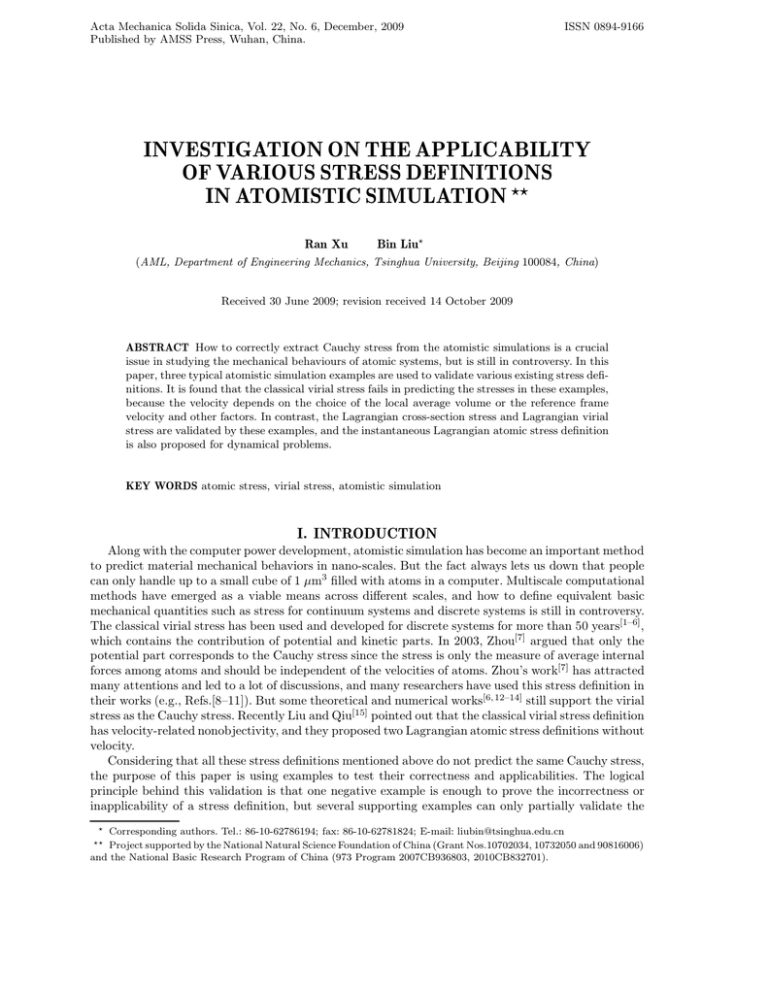
Acta Mechanica Solida Sinica, Vol. 22, No. 6, December, 2009 Published by AMSS Press, Wuhan, China. ISSN 0894-9166 INVESTIGATION ON THE APPLICABILITY OF VARIOUS STRESS DEFINITIONS IN ATOMISTIC SIMULATION ⋆⋆ Ran Xu Bin Liu⋆ (AML, Department of Engineering Mechanics, Tsinghua University, Beijing 100084, China) Received 30 June 2009; revision received 14 October 2009 ABSTRACT How to correctly extract Cauchy stress from the atomistic simulations is a crucial issue in studying the mechanical behaviours of atomic systems, but is still in controversy. In this paper, three typical atomistic simulation examples are used to validate various existing stress definitions. It is found that the classical virial stress fails in predicting the stresses in these examples, because the velocity depends on the choice of the local average volume or the reference frame velocity and other factors. In contrast, the Lagrangian cross-section stress and Lagrangian virial stress are validated by these examples, and the instantaneous Lagrangian atomic stress definition is also proposed for dynamical problems. KEY WORDS atomic stress, virial stress, atomistic simulation I. INTRODUCTION Along with the computer power development, atomistic simulation has become an important method to predict material mechanical behaviors in nano-scales. But the fact always lets us down that people can only handle up to a small cube of 1 µm3 filled with atoms in a computer. Multiscale computational methods have emerged as a viable means across different scales, and how to define equivalent basic mechanical quantities such as stress for continuum systems and discrete systems is still in controversy. The classical virial stress has been used and developed for discrete systems for more than 50 years[1–6], which contains the contribution of potential and kinetic parts. In 2003, Zhou[7] argued that only the potential part corresponds to the Cauchy stress since the stress is only the measure of average internal forces among atoms and should be independent of the velocities of atoms. Zhou’s work[7] has attracted many attentions and led to a lot of discussions, and many researchers have used this stress definition in their works (e.g., Refs.[8–11]). But some theoretical and numerical works[6, 12–14] still support the virial stress as the Cauchy stress. Recently Liu and Qiu[15] pointed out that the classical virial stress definition has velocity-related nonobjectivity, and they proposed two Lagrangian atomic stress definitions without velocity. Considering that all these stress definitions mentioned above do not predict the same Cauchy stress, the purpose of this paper is using examples to test their correctness and applicabilities. The logical principle behind this validation is that one negative example is enough to prove the incorrectness or inapplicability of a stress definition, but several supporting examples can only partially validate the Corresponding authors. Tel.: 86-10-62786194; fax: 86-10-62781824; E-mail: liubin@tsinghua.edu.cn Project supported by the National Natural Science Foundation of China (Grant Nos.10702034, 10732050 and 90816006) and the National Basic Research Program of China (973 Program 2007CB936803, 2010CB832701). ⋆ ⋆⋆ · 2 · ACTA MECHANICA SOLIDA SINICA 2009 applicability, and the theoretical proof is also needed. The paper is organized as follows: in §II, we first present various definitions of atomic stress, then test them with static examples in §III and one dynamic example in §IV. Besides, an instantaneous Lagrangian atomic stress definition is proposed in §IV. Conclusions are drawn in §V. II. VARIOUS DEFINITIONS OF STRESS IN ATOMISTIC SIMULATION There are two kinds of classical virial stress definitions. The first one is 1 X 1 X σ= − mi v i ⊗ v i + r ij ⊗ f ij V 2 i (1) i,j6=i where f ij is the force on atom i exerted by atom j, r ij the relative position vector from atom i to j, V the volume to perform statistical average, mi and v i are the mass and the velocity vector of atom i, respectively. The second classical virial stress definition is X 1 X 1 − mi v local ⊗ v local + rij ⊗ f ij (2) σ= i i V 2 i i,j6=i where v local = v i − v̄ is the local velocity relative to the average velocity v̄ in the local volume. To i distinguish between these two virial stress definitions, hereafter, we name Eq.(1) the global velocity virial stress since v i is the global velocity relative to the reference frame, and name Eq.(2) the local velocity virial stress. The classical stress in Eqs.(1) or (2) can be divided into two parts, the kinetic and potential ones, which correspond to the first and second terms, respectively. Zhou[7] argued that only the potential part corresponds to the Cauchy stress since the stress is only the measure of average internal forces among atoms and should be independent of the velocities of atoms, and he therefore suggested the following stress definition 1 X σ= r ij ⊗ f ij (3) 2V i,j6=i By strictly following the classical definition of the Cauchy stress for a continuum medium, Liu and Qiu[15] proposed a fundamental Lagrangian atomic stress definition as, * + X 1 f Lag n·σ = = f iR (4) S S i∈Lag Set L f Lag iR where h·i denotes the temporal average, is the force on atom i exerted by the atoms in Lagrangian Set R (colored black) as shown in Fig.1, S is the cross-sectional area of the volume element and n is Fig. 1. A Lagrangian volume element for computing the Lagrangian cross-section stress. Open circles and solid dots represent the left and right Lagrangian sets, respectively. Vol. 22, No. 6 Ran Xu et al.: Investigation on Applicability of Various Stress Definitions · 3 · the unit normal vector of the dividing plane. It should be emphasized that the cut between the two sets is a Lagrangian (or material) dividing plane; namely each atom will not change its belongingness to Set L or Set R. For easy identification, we call the stress from Eq.(4) the Lagrangian cross-section stress hereafter. Liu and Qiu[15] also proposed a Lagrangian virial stress definition as follows σ= 1 X hrij i ⊗ hf ij i 2V (5) i,j6=i These two Lagrangian atomic stress definitions, Eqs.(4) and (5), do not involve the velocity in their expressions, therefore the velocity-related nonobjectivities can be avoided. In the following sections, we test the above stress definitions via three examples, and discuss their applicabilities. III. THERMOMECHANICAL EQUILIBRIUM EXAMPLES 3.1. Atomic Bar under Static Tension We first study an atomic bar under uniaxial static tension as shown in Fig.2, which is the simplest loading condition. This atomic system includes 9850 atoms, and the interatomic potential is a harmonic 2 one, 21 k (rij − b0 ) , where b0 is the equilibrium bond length. This atomic bar is in thermomechanical equilibrium at temperature T = 0.7kb20 /kβ . A given tensile stress σ̄xx = 0.315k/b0 is applied at the ends along the x-direction. According to the force balance, the Cauchy stress in the bar should be σ̄xx , and this atomic system can serve as a benchmark example to check various stress definitions. From Fig.2, we can find that the Lagrangian cross-section stress and Lagrangian virial stress yield the accurate result. If the velocity of the mass center is zero, the global velocity virial stress Eq.(1) can also predict the correct value, because the applicability conditions suggested by Liu and Qiu[15] are satisfied. However, the stress from Zhou’s definition Eq.(3) is obviously higher than the true value. Regarding the relevant discussion on these applicabilities, the reader is referred to Liu and Qiu’s paper[15] . It can be expected that if the mass center of the bar has a nonzero velocity relative to the reference frame, the stress from global velocity virial stress (Eq.(1)) would give a wrong prediction. Therefore, the local velocity virial stress seems more reasonable. However, the situation in computing Eq.(2) becomes a bit of complex, since the local velocity v local = v i − v̄ may depend on the choice of the local volume, i i.e., different-sized local volumes may lead to different v̄. Figure 3 shows the local velocity virial stress as a function of the local volume size. With a smaller local volume, the local velocity virial stress is significantly higher than the global one, and it will approach the accurate value as the volume size increases. This trend can also be strictly proved as follows. The potential part in Eq.(2) is obviously independent of the average velocity v̄ in the local volume. We therefore investigate the kinetic part and only one-dimensional velocity is considered for simplicity. Assume there are 2N atoms in this atomic bar. We may use the whole bar to compute v̄, or divide the bar into part 1 with mass M (1) and part 2 with mass M (2) , and compute the corresponding v̄ (1) and Fig. 2. The stress obtained from various atomic stress definitions for an atomic bar under tension. Fig. 3. Variation of the local velocity virial stress in an atomic bar under tension as a function of the size of the local volume. · 4 · ACTA MECHANICA SOLIDA SINICA 2009 v̄ (2) , respectively. The kinetic parts of stresses in these two ways are global σKinetic 2N 2N 1 X 1 X 2 =− mi (vi − v̄) = − mi V i=1 V i=1 =− local σKinetic = 2N 1 1 X mi vi2 + (1) V i=1 V M + M (2) σ (1) V (1) + σ (2) V (2) V N 1 X 1 mi vi2 − (1) =− V i=1 M N X i=1 mi vi 2N X 1 vi − (1) mi vi M + M (2) i=1 !2 2N X mi vi where P (1) = N P i=1 mi vi and P (2) = 2N P (6) i=1 !2 2N X 1 + mi vi2 − (2) M i=N +1 The difference between Eqs.(6) and (7) is global local σKinetic − σKinetic = !2 2N X i=N +1 !2 mi vi 2 1 P (1) M (2) − P (2) M (1) ≥0 V M (1) M (2) M (1) + M (2) (7) (8) mi vi are the momentums of part 1 and part 2, respectively. i=N +1 It should be pointed out that the above derivation also holds for other partitions with many smaller average volume elements. Equation (8) implies that a smaller local average volume will cause a larger local velocity virial stress, unless P (1) M (2) − P (2) M (1) = 0, just the same as our simulation results in Fig.3. An extreme case showing the dependence of the local velocity virial stress on the local volume size is Zhou’s stress definition Eq.(3), which can be viewed as the smallest local volume including only one atom, i.e., v̄ = v i in Eq.(2). Therefore, Zhou’s stress is always larger than the global velocity virial stress. Another interesting thing is that if the atomic system is under different loading conditions, the best local average volume size for determining the accurate atomic stress may be different. For a gas atomic system under gravitational equilibration, by calibrating the continuum solution, Hoover et al.[12] chosed a specific local average volume size (local weight function h = 3 used in their paper) to determine v̄. However, for the bar under tension, our simulation shows that the whole bar should be used to compute v̄. Therefore, one question arises immediately — if one does not know the exact stress solution, how does he or she set the local average volume size? 3.2. Ions System under Alternating Electric Fields The previous section shows that the local velocity in the virial stress relies on the choice of local average volumes. Now we simulate an extreme example: a box is filled with some ions, and their interactions is 2 still 21 k (rij − b0 ) , as shown in Fig.4. The mass and the charge of an ion are m and ±q, respectively. We p then apply an alternating electric field E with a frequency 0.3k/m to this system. After sufficiently long time evolution, this atomic system is finally in thermomechanical equilibrium, and the temporal average of electric forces is zero, therefore the Cauchy stress should be zero according to continuum mechanics. However, our simulation in Fig.4 shows that the global/local virial stress predicts a nonzero stress for a larger E. This obvious inconsistency between Cauchy stress and the classical virial stress further indicates that this definition is not widely applicable due to the involvement of the velocity which relies on too many factors. However, the Lagrangian cross-section stress and Lagrangian virial stress can always predict the correct value for any E, which demonstrates that Liu and Qiu’s stress definition in Eqs.(4) and (5) is more objective than the classical virial stress. IV. DYNAMICAL EXAMPLE AND INSTANTANEOUS ATOMIC STRESS DEFINITION In this section, we simulate the dynamical behavior of the bar in Fig.2. The bar is initially under static tension, then the loading is suddenly released and the bar starts to vibrate freely. Figure 5 shows Vol. 22, No. 6 Ran Xu et al.: Investigation on Applicability of Various Stress Definitions Fig. 4. The normalized stress in an ion system v.s. the applied alternating electric field. · 5 · Fig. 5. The normalized stress from various stress definitions v.s. the normalized time for a bar in free vibration. the variation of the stress at the cross-section A (see the inset) as a function of the normalized time. The instantaneous Lagrangian cross-section stress can be computed from Eq.(4) without temporal average as X 1 f Lag fiR (9) n·σ = = S S i∈Lag Set L and the Lagrangian dividing plane should be performed based on the average atom positions. Same as the dynamic stress definition in the continuum mechanics, this instantaneous Lagrangian cross-section stress is therefore accurate. Figure 5 also shows that the global velocity virial stress deviates from the correct stress. By carefully choosing the local average volume (177 atoms in our simulation), the local velocity virial stress may predict the true value, but the dynamic stress still depends on the size of the local average volume. Considering the stress definition in the virial form is easy to compute, we also propose an instantaneous Lagrangian virial stress, 1 X hr ij i ⊗ f ij (10) σ= 2V i,j6=i which can be derived from Eq.(9) by following the approach in Liu and Qiu’s paper[15] . It is found from Fig.5 that this instantaneous Lagrangian virial stress agrees well with the accurate results, and no arbitrary parameter needs to be fitted. V. CONCLUSIONS In order to clear the controversy on the computation of Cauchy stress for atomic systems, three typical atomistic simulation examples are used to validate various existing stress definitions. The following conclusions can be drawn: (1) Zhou’s stress definition fails in predicting the stress in the atomic bar under tension. (2) The velocity in the classical virial stress definition depends on the choice of the local average volume or the reference frame velocity, which makes the corresponding stress computation inconsistent. (3) The second example indicates that the external body force can change the velocity while keeping the Cauchy stress zero, and the velocity-based classical virial stress definition can not predict the correct stress value. (4) The Lagrangian cross-section stress and Lagrangian virial stress pass all three testing examples, and a new instantaneous Lagrangian atomic stress definition is proposed for dynamical simulations. The above conclusions are obtained from the numerical studies in this paper, which completely support Liu and Qiu’s theoretical work and predictions[15] . References [1] Irving,J.H. and Kirkwood,J.G., The statistical mechanical theory of transport processes — 4. The equations of hydrodynamics. Journal of Chemical Physics, 1950, 18: 817. · 6 · ACTA MECHANICA SOLIDA SINICA 2009 [2] Tsai,D.H., Virial theorem and stress calculation in molecular-dynamics.22 Journal of Chemical Physics, 1979: 70-1375. [3] Hardy,R.J., Formulas for determining local properties in molecular — dynamics simulations-shock-waves. Journal of Chemical Physics, 1982: 76-622. [4] Lutsko,J.F., Stress and elastic-constants in anisotropic solids — molecular-dynamics techniques. Journal of Applied Physics, 1988, 64: 1152. [5] Cormier,J., Rickman,J.M. and Delph,T.J., Stress calculation in atomistic simulations of perfect and imperfect solids. Journal of Applied Physics, 2001, 89(1): 99-104. [6] Zimmerman,J.A., Webb,E.B., Hoyt,J.J., Jones,R.E., Klein,P.A. and Bammann,D.J., Calculation of stress in atomistic simulation. Modelling and Simulation in Materials Science and Engineering, 2004, 12(4): S319S332. [7] Zhou,M., A new look at the atomic level virial stress: on continuum-molecular system equivalence. Proceedings of the Royal Society of London Series A — Mathematical Physical and Engineering Sciences, 2003, 459(2037): 2347-2392. [8] Li,X.T. and ,E.W., Multiscale modeling of the dynamics of solids at finite temperature. Journal of the Mechanics and Physics of Solids, 2005, 53(7): 1650-1685. [9] Diao,J.K., Gall,K., Dunn,M.L. and Zimmerman,J.A., Atomistic simulations of the yielding of gold nanowires. Acta Materialia, 2006, 54(3): 643-653. [10] Park,H.S. and Ji,C.J., On the thermomechanical deformation of silver shape memory nanowires. Acta Materialia, 2006, 54(10): 2645-2654. [11] Olsson,P.A.T., Melin,S. and Persson,C., Atomistic simulations of tensile and bending properties of singlecrystal bcc iron nanobeams. Physical Review B, 2007, 76(22): Article Number: 224112. [12] Hoover,W.G. and Hoover,C.G., Microscopic and macroscopic stress with gravitational and rotational forces. Physical Review E, 2009, 79: 036709. [13] Arum K.Subramaniyan and Sun,C.T., Continuum interpretation of virial stress in molecular simulations. International Journal of Solids and Structures, 2008, 45: 4340-4346. [14] Van Dommelen L., Physical interpretation of the virial stress. 2003. http://www.eng.fsu.edu/∼dommelen/ papers/virial/index.pdf [15] Liu,B. and Qiu,X.M., How to compute the atomic stress objectively? Journal of Computational and Theoretical Nanoscience, 2009, 6: 1081-1089.
